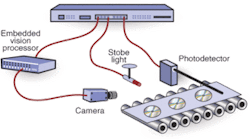Emerging standards and networks benefit integrators
In many machine-vision systems, bus-based standards such IEEE 1394 are gaining increasing importance as plug-and-play camera-to-computer interfaces. At the same time, switched-packet architectures such as Ethernet and Gigabit Ethernet are being incorporated into many smart cameras and stand-alone systems.
Last summer, for example, National Instruments (Austin, TX, USA; www.ni.com) announced its NI-1455 machine-vision system, an Ethernet-compatible unit that supports up to three FireWire-based cameras. In December, Pleora Technologies (Kanata, ON, Canada; www.pleora.com) announced that a working Gigabit Ethernet standard for imaging applications should now be available. At the 2003 VISION Show in Stuttgart, Germany, GigaLinx (Ramat Gan, Israel; www.gigalinx.net) also entered the machine-vision/image-processing market with a series of products designed to add DSP-based processing to Gigabit Ethernet systems.
In these systems, the trend away from the PC-based camera-to-frame grabber interface is apparent. Using such systems, developers can deploy distributed processing nodes on automated manufacturing lines without the cost associated with deploying a PC-based system at each node.
Matthew Linder, president and CEO of Valde Systems (Brookline, NH, USA; www.valdesystems.com), says, "In camera-to-PC-based frame-grabber configurations, the frame-grabber card interfaces to the camera and acts as a central timing-control point with dedicated hardware to control the camera and strobe lighting." Although this may appear to be relatively simple to implement, the interface card can be complex and expensive, and, since there are no standard pinouts to the devices it must control, custom cables and breakout boxes may also be required. In addition, all the devices connected to the frame grabber have some amount of indeterministic behavior associated with them that may cause problems, especially in higher-speed systems that require tighter timing tolerances between devices.
Valde Systems plans to debut its first product that overcomes these limitations, a DSP-based vision processor, at The Vision Show East (May 4-6; Boston, MA, USA; www.machinevisiononline.org). With two independent PHY/LINK FireWire interfaces, the vision processor will be based on the Texas Instruments (TI; Dallas, TX, USA; www.ti.com) 64x series of DSPs. Featuring 32 Mbytes of on-board memory and an Ethernet interface, the system will be shipped with a library of C-callable routines.
"Although the system will support the TI library of imaging functions, developers can use any TI 64x-compatible compiler to develop their systems," says Linder. Developed for high-volume OEM applications, the system initially will not be offered with drag-and-drop or off-the-shelf machine-vision software. "By targeting the embedded, networked machine-vision market," says Linder, "the developer will not have to pay operating system or software licenses. Although this will increase the development time, the volume price reduction will make this worthwhile," Linder adds.
Initially offered as a 5 × 6 × 2-in. stand-alone unit, Linder's future plans for the processor include a smart-camera version and a PCI-based preprocessor add-in card. But perhaps the most important developments on the drawing board at Valde Systems include future use of networks such as Ethernet. "With the introduction of voice-over-IP telephones, the standard of IEEE-802.3af, or Power over Ethernet," he says, "it is possible to use the network to deliver power to the components of the machine-vision system, removing the necessity of using separate power supplies for each component."
It's not just power that future network-based systems may deliver. The recent IEEE 1588 standard specifies a precision clock-synchronization protocol for networked measurement and control systems. "While not tied to a specific network implementation, IEEE 1588 works by measuring the delays between sections of the network and using in-band signaling to adjust its local oscillator," Linder says. And, depending on the accuracy of the local oscillator, submicrosecond accuracy can be achieved. This will be very useful in future systems where devices such as high-speed shutters and strobe lights that comply with the standard could be programmed to occur in synchronization with the camera trigger.
"With the proliferation of Ethernet devices," adds Linder, "the cost and difficulty of implementing an Ethernet interface on a device is no longer a factor. If these devices could operate independently and communicate in a synchronized deterministic fashion, control could be decentralized and overall system cost reduced. Because these devices all have a well-defined interface, the problem of custom cables and breakout boxes is eliminated."

